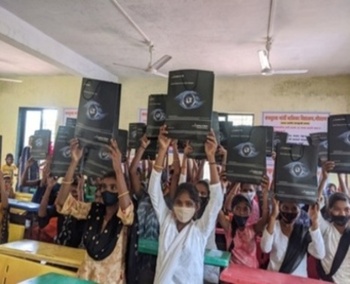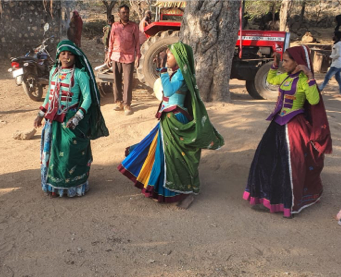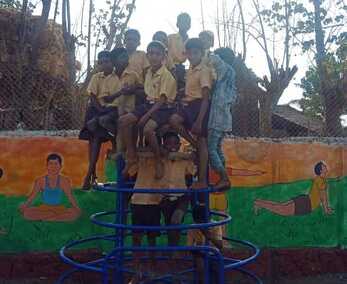What Makes a ‘Model Village’? Learnings from Pingeman Village

What does a model village mean to you? Do you instantly begin to picture clean roads, well-lit homes, and thriving farms? The reality of rural India is more complex and far more inspiring. For the villagers of Pingeman, nestled by the Vaitarna river in Maharashtra, the idea of transformation went beyond being a dream; it became a shared mission.
What makes Pingeman remarkable is not just what changed, but how it changed through the power of solar energy, strategic partnerships, and deep community ownership. This story is a shining example of social development in villages done right.
At Project Chirag, Pingeman is not just a milestone. It is a living, breathing proof of concept, a reminder that rural development, when done right, is not charity; it’s empowerment.
Sustainable Village Development: Why Pingeman Needed Transformation?
Pingeman was not unlike thousands of rural villages scattered across India, rich in potential but starved of opportunity. It lay close to the Vaitarna river, yet its farmlands stood parched for most of the year. The irony was gut-wrenching: acres of cultivable land lay dry while families depended on unpredictable monsoons to sow a single seasonal crop, barely enough to eat, let alone sell.
The school building, a cornerstone for village learning, was in poor shape, with no electricity, no toilets, and no safe drinking water. Teachers were motivated but had very little to work with. With no fans or lighting, classrooms were barely usable in the summer heat or after dusk. It was a place that should have ignited dreams, but instead dimmed them.
Migration had become the norm. After the rains, men and women left in search of daily-wage labour, often working in exploitative conditions at brick kilns or construction sites. Children were pulled out of school to accompany their families, breaking the cycle of learning before it could begin. Access to even the most basic rights, light, clean water, toilets, and income, was absent.
But what set Pingeman apart was this: the community was willing to participate in change. The school faculty actively sought support. The gram panchayat cooperated. And when Project Chirag entered, what followed was not a “handover” but a handshake, a partnership grounded in trust, planning, and the shared desire for transformation.
Pingeman didn’t just need a change. It was ready for it.



Solar-Powered Villages: How Pingeman Became a Model for Rural India?
The transformation in Pingeman was driven by Project Chirag’s Integrated Village Development Model, a 5-point framework that focuses on energy, education, water, livelihoods, and empowerment. This holistic approach has become one of the most inspiring village development success stories in the country.
Here’s what the model looked like and why it worked:
Energy as the Enabler
- A 7.5 HP solar pump irrigates previously unused land, enabling multi-cropping and year-round agriculture ● 5 strategically placed solar streetlights bring safety, connectivity, and dignity to communal life
- A 3.5 KW solar system powers classrooms and computer labs, ending the cycle of learning in the dark
From Classrooms to Confidence
- The school received a full-scale overhaul: repaired infrastructure, clean toilets, and B.A.L.A. (Building as Learning Aid) model integration as part of Integrated School Development
- A solar-powered computer lab with 4 systems now teaches digital literacy to first-generation learners
- ● Solar cookers in the kitchen support the midday meal scheme, making it healthier and more sustainable
Water That Changed Everything
- A 1.5 HP solar pump now fills an overhead tank, connected to an ultrafiltration unit, ensuring clean water for all 450 residents
- ● Women no longer spend hours fetching water from distant, unsafe sources
- With access to irrigation, the village has started being more self-reliant
Potential For Improved Livelihoods Rooted in Local Soil
- Seasonal migration would decline, and villagers will now be able to earn from their land instead of leaving it behind ● Women-led self-help groups can now grow vegetables like methi and bhindi, and sell produce in nearby markets ● Brinjal patches outside homes and revived soil can turn land into a source of dignity, not debt
The Ripple Effect: A Village Reimagined
School attendance has increased, especially among girls who once stayed home due to unsafe infrastructure. Health indicators are improving, with fewer waterborne illnesses and better nutrition from local crops. Most importantly, the community feels a sense of ownership from planning to maintenance; they’ve led the charge.
As one woman farmer shared,
“I climb down to cross the river and sell my vegetables. It’s tough, but I feel proud. I earn nearly Rs 250 a day from what I grow.” This is what real empowerment looks like: when communities don’t just benefit from change, they own it.
What Makes a Model Village in India? Lessons from Pingeman
With over 6.6 lakh villages in India, Pingeman proves what’s possible when we move from scattered aid to systemic, community-led solutions.
So what makes it a model village?
- It addressed multiple challenges simultaneously
Education, water, sanitation, lighting, and livelihoods, all solved together in a phased and cohesive manner, showcasing true sustainable village development.
- The community co-created the change
From donating land (bhudaan) to trench-digging (shramdaan), villagers were active partners, not passive beneficiaries.
- It pivoted on clean, reliable energy
With solar power at the core, Pingeman became a climate-resilient, carbon-light village model.
- The impact is visible and trackable
School attendance is up. Income is stable. Health indicators are improving. And dignity is palpable.
- It’s scalable
This isn’t a one-village story. The systems used in Pingeman, solar grids, ultrafiltration units, and computer labs, can be replicated across rural India with the right partners and policies.
Pingeman isn’t a one-off miracle. It’s a roadmap for CSR in rural development, and a ready reference for any ngo for rural development in India working in water, education, and energy access.
Lessons to Take Away:
- Work with communities, not just for them
- Design for integration, not isolation
- Make solar the pivot for sustainable infrastructure
- Track outcomes and plan for long-term ownership
- Build partnerships that go beyond funding, and a shared mission sustains momentum
Support Sustainable Village Development with Project Chirag
Inspired by Pingeman? Want to support village development that actually works?
Project Chirag invites:
- CSR partners seeking high-impact, scalable projects
- HNIs and foundations looking to create a meaningful legacy
- Institutions ready to fund climate-smart rural infrastructure
Support Rural Development. Let’s build not just villages, but vibrant, self-sustaining communities across India.





